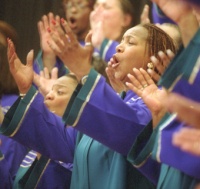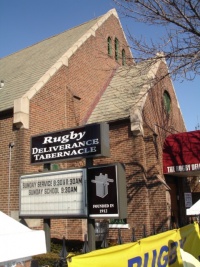Christian Church as an Immigrant Association
From Seminar 2: The Peopling of New York City
Ceena Chandrabos
Contents |
Introduction
The focus of this study will be on West Indian Churches, and how they provide immigrants with ways to maintain their cultural ties, as well as opportunities to overcome barriers to educational, employment, social opportunities. Like many religious institutions have done in the past, West Indian churches in New York serve dual roles as immigrant organization and as spiritual community. To fully understand this concept, the following will be examined: (1) transnationalism with a focus on immigrant associations, (2) Caribbean elements in West Indian Christianity, and (3) fieldwork that explores the spiritual and ethnic ties fostered by West Indian ethnic churches in the lives of immigrants.
The Nature of Transnational Immigrant Associations
Migrants today lead transnational lives, which can be defined as "practices that extend beyond household and family networks to include organizations that link home country with one or more societies in which its population has settled” (Basch et al 56). Such “immigrant voluntary associations” aid in forming the migrants transnational identity, in which they can relate to their country of origin, as well as the country of settlement (Bach et al 48). These organizations not only provided the immigrant a level of ethnic solidarity, but also social networks. Additionally, it is a place that facilitates adaptation to the new country, while also providing a place for reviving home culture in the face of assimilating pressures that target an immigrant’s life (Basch et al 56).
Immigrant Christian Churches
While West Indian churches primarily act as a spiritual community, it can also serve as an immigrant association. By definition, these churches provide the members of the congregation an opportunity to embrace their Caribbean culture within the context of Christianity, and thereby fostering transnational identitiy promoting transnational ideities. The complex West Indian elements incorporated into Christianity involved a blending, African culture from the slaves who were brought into the Caribbean with the highly structured European Christianity, mainly English Anglicanism and French Catholicism (Schmidt 236). As the largest West Indian migrants to New York overwhelming come from the British West Indies, all of whom share a history of common ancestry in British imperialism, Creole culture, and long-term economic dominance of plantation agriculture, it is more expedient to discuss Christian sects that have arisen from this area (Foner 6).
Origin of Distinct West Indian Culture in Christianity
Several elements of African culture were blended into Christianity as a result of syncretism (Sankeralli 57). The following are several characteristics common to many West Indian Christian sects:
- One such modification includes the increased importance of salvation, which enshrined freedom from sin and oppressors, as displayed by the Biblical account of the deliverance from Egypt (Sankeralli 27).
- Drums were incorporated into Christianity because it was a form of communication among African slaves; communication by drums was powerful because slave owners were incessantly fearful of slave interaction that might potentially lead to a rebellion (Schmidt, 237). The use of drums may also have been a result of cultural crossover from vodou practices. (Schmidt 237).
- Charismatic praise and worship also traces back to African cultural roots. African culture holds that a spiritual experience or presence must be celebrated with the whole body. Accordingly, drums, tambourines, musical harmony, and lyrics are all used to aid worship services. This is also one of the main reason why gospel choirs are a very important to West Indian churches (Sankeralli 52). Praise and worship, like vodou, maybe be a way to attain a “spiritual healthy” state of possession. The first possession is for a “spiritual cleansing”, while subsequent possessions aid in spiritual growth and maturity (Sankeralli 33).
- Female ministers and pastors can be explained by African culture as well, since African religions employ the use of both male and female priests (Sankeralli 52).
These distinct qualities are unique to West Indian Christianity, and show that as a spiritual community they profess not only their faith, but also their West Indian culture.
Caribbean Churches in New York
Clifford Hill notes an interesting phenomenon among West Indian migrants in Britain. Despite British rule in the West Indian colonies, West Indians migrants selected West Indian sects in their own enclaves over British religious institutions (Hill 114). Hill’s examination has led him to believe that one of the reason's for West Indian rejection of British churches is socio-cultural issues, which involves prejudice and rejection of traditional Established churches that have no incorporation of West Indian culture (Hill 117).
Field work in the Flatbush reveals that the situation parallels the migration of West Indians into New York. Migrants typically feel more comfortable in ethnic enclaves, where social solidarity provides comfort. This recreated West Indian community shows transnation elements in religion, and ways in which it aids migrants to maintain ties to homeland and New York City. Many sects of West Indian Church are located on Church Avenue. These churches are often reflective of the practices in their Caribbean counterparts.
Transnational Ties Fostered by Christianity
West Indian Churches in Light of a Religious Community
For fieldwork, I interviewed a middle-aged female Jamaican migrant named Edna White, who highlighted the ways in which her church functions a spiritual community promoting transnationalism. While in Jamaica, she attended a Pentecostal church named Faith Standing Church of the Living God, and continues to attend a West Indian Pentecostal Church in Brooklyn called Nehemiah and Hannah’s Outreach Mission.
Religious practices in both, the church aboard and the church at home, reveal the spiritual and ethnic connection the churches share. In the case of Nehemiah and Hannah’s Outreach Mission, such practices such as music, praise and worship, and strict interpretation of the Bible are all elements carried over from the Faith Standing Church of the Living God. Additionally, the style of dressing on Sunday is very similar to that of the church in their homeland. For example, majority of the female attendees of Nehemiah and Hannah’s Outreach Mission wear skirts, and preferably hats or head coverings, which is typically worn at home churches. Interestingly, when Ms. White was asked in what ways her religion has helped her identify with her Jamaican identity, she responded that it was through the preaching, Bible studies and such. Therefore, in partaking in religious practices in church, she find that she is tapping into her ethnic roots as well. In this manner, it seems that she is able to spiritual connect to her home country by partaking in church activities. As Edna White says, “Basically, what we did back there, they [pastor and co-pastor] try to instill in it in us here-like following the right path and things.”
Furthermore, kinship ties to members of the church in Brooklyn, as well as members back in Jamaica was also expressed during the interview. When asked her reason for attending this particular church, she mentioned three reasons. Firstly, her brother – in – law and sister are the pastor and co-pastor respectively of the church. Secondly, the members of the Nehemiah and Hannah’s Outreach Mission were all once members of the same church in Jamaica. Thirdly, during conventions, where branches of Jamaican churches get together, members of the congregation take the opportunity to go home to Jamaica and visit families and friends and catch up the latest news in their hometowns, and also make donations to the their home churches. Additionally, the church shares a very close relationship with its teenage attendees. They accomplish this by encouraging them with Bible Study games, and dinner nights to prevent them from involvement with gangs, drugs, and peer pressure. All of the above show examples of ways in which West Indian churches encourage kinship ties.
West Indian Churches in Light of Transmigrant Associations
In addition to promoting transnational ties, West Indian churches also provide services that aid immigrants in their adaptation to New York City, which shows the incorporation of elements of transmigrant associations. One epitomic example of this is Rugby Deliverance Tabernacle, a non-denominational West Indian church located off of Church Ave. Like Nehemiah and Hannah’s Outreach Mission, Rugby shares West Indian characteristics in the style of thier Sunday Masses. In addition, A Family Services is attached to the Church that provide immigrants help in adapting to New York City. Service provided include counseling for domestic violence victims, G.E.D classes, computer classes, immigration information, student scholarship, Medicare/Medicaid and the feeding program. In addition to these services, family services offer help for getting government aid, collaborate with organization to hold community events, and hold seminars for starting businesses and teenage abuse. Thus, West Indian church communities function in some ways as a transmigrant association in providing services that offer immigrants aid to make the most out of their migration to New York City.Works Cited
- Islands in the City: "West Indian Migration to New York." Nancy Foner, ed. New York: Columbia University Press.
- Glick Schiller, Nina; Linda Basch, Cristina Szanton Blanc (1995) "From Immigrant to Transmigrant: Theorizing Transnational Migration". Anthropological Quarterly, Vol. 68, No. 1: 48-63.
- Hill, Clifford (1971).From Church to Sect: West Indian Religious Sect Development in Britain. Journal for Scientific Studies of Religion. 10, 115-123.
- Kiev , Ari (1964).Psychotherapeutic Aspect of Pentecostal Sect Among West Indian Immigrants to Britain. The British Journal of Sociology. 15, 129-138.
- Mitchell, Mozella. Crucial Issues in Caribbean Religions. . New York: Peter Lang Publishing Inc, 2006.
- Sankeralli, Burton (Ed.). 1995. At the crossroads: African Caribbean Religion & Christianity /. St. James, Trinidad & Tobago: Caribbean Conference of Churches.
- Schmidt, Bettina (2006).The Creation of Afro-Caribbean Religions and their Incorporation of Christian Elements: A Critique against Syncretism. Transformation 23/4. 236-242.
- Smith, Robert. (1950). Slavery and Christianity in the British West Indies. Church History. 19, 171-186.
1 Church Instruments http://www.aues21.dsl.pipex.com/images/Tambourine1.jpg http://img339.imageshack.us/img339/9145/yamahapsr340ss2.jpg http://www.jddrumcenter.com/communities/004/005/523/730/images/4512197172.jpg http://img.alibaba.com/photo/10838003/Acoustic_Bass_Guitar.jpg
2 Gospel Choir http://www.sonoma.edu/pubs/nb/images/gospel.jpg


